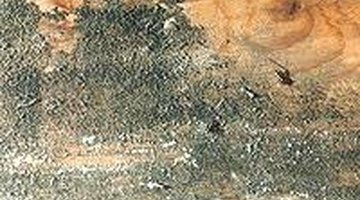Removing Black Mold From Rough Sawn Lumber Beams
Table of Contents
Though black mold is undesirable on rough sawn lumber, it is neither particularly dangerous or difficult to remove in most cases. Black mold can be an irritant for people with certain allergies, and people with severe allergies can be made very sick by being in close proximity to black mold spores.

About Black Mold on Rough Sawn Lumber
But other than in these situations, it does not pose a major risk. Mold development can be quite severe, but for a case of mold to be too extensive to clean using ordinary methods, the wood will also be rotten to the point where it won't be useful for building products. Once you clean black mold from an otherwise healthy beam of rough sawn lumber, that beam will remain healthy and mold-free for as long as you keep it away from stagnant moisture and active mold spores.
Cleaning Black Mold From Lumber Indoors
If working indoors, clean the mold up carefully by hand to control the spread of spores. To be on the safe side, wear a microbial-grade breathing mask while doing this, and anyone with a severe mold allergy should vacate the premises for a few hours. All you'll need are rubber gloves, lots of paper towels and either a bucket of ordinary warm water or water with a little mild liquid dish soap mixed in. Clean the mold by soaking a paper towel, wringing out the excess, folding it over and wiping one small section at a time. The surface mold should come off easily. As you wipe, refold and continuously discard the paper towels so that you do not spread mold around to other sections of the lumber. Remove all of the surface mold, while taking care to not just move it around. When done, allow the lumber to air dry and dispose of the soiled paper towels.
Cleaning Black Mold From Lumber Outdoors
If you're working on cleaning lumber that has been installed to the exterior of a structure or that is just sitting in a lumber yard, there's a faster and easier (albeit messier) method. Use a power washer to blast the surface mold away with clean water and allow the beams to dry in the open air and sunshine.
Why Not to Use Bleach
It's commonly accepted knowledge that bleach can kill mold spores; however, using bleach isn't the best approach when cleaning black mold from lumber. Bleach is often used in environments that need to be as sterile as possible, like hospitals and labs. Homes, office buildings and other types of structures don't need this clinical level of cleanliness, which is good, because completely ridding a structure of all mold is a nearly impossible task. Furthermore, if you just spray bleach on mold without physically removing the surface mold, you may end up killing only a little bit of the mold while allowing the rest to spread. Bleach can also dry out and stain the lumber itself, and it is messier and more dangerous to work with than just soap and water. If you remove the surface mold, you can stop the growth and reduce the presence of mold allergens to a safe, normal level without using bleach at all.
How to Remove Mold Stains
When the mold is gone and the lumber is dry, black or gray stains may be left behind. With rough sawn lumber, the best solution may be to sand down the wood. Unless the mold growth was very old and extensive, it won't have penetrated the surface too far, and you may be able to sand all of it out. Paint or a dark wood stain would obscure these mold stains as well.
The Drip Cap
- Though black mold is undesirable on rough sawn lumber, it is neither particularly dangerous or difficult to remove in most cases.
- Mold development can be quite severe, but for a case of mold to be too extensive to clean using ordinary methods, the wood will also be rotten to the point where it won't be useful for building products.
- The surface mold should come off easily.
- As you wipe, refold and continuously discard the paper towels so that you do not spread mold around to other sections of the lumber.
- Bleach is often used in environments that need to be as sterile as possible, like hospitals and labs.
- Furthermore, if you just spray bleach on mold without physically removing the surface mold, you may end up killing only a little bit of the mold while allowing the rest to spread.



